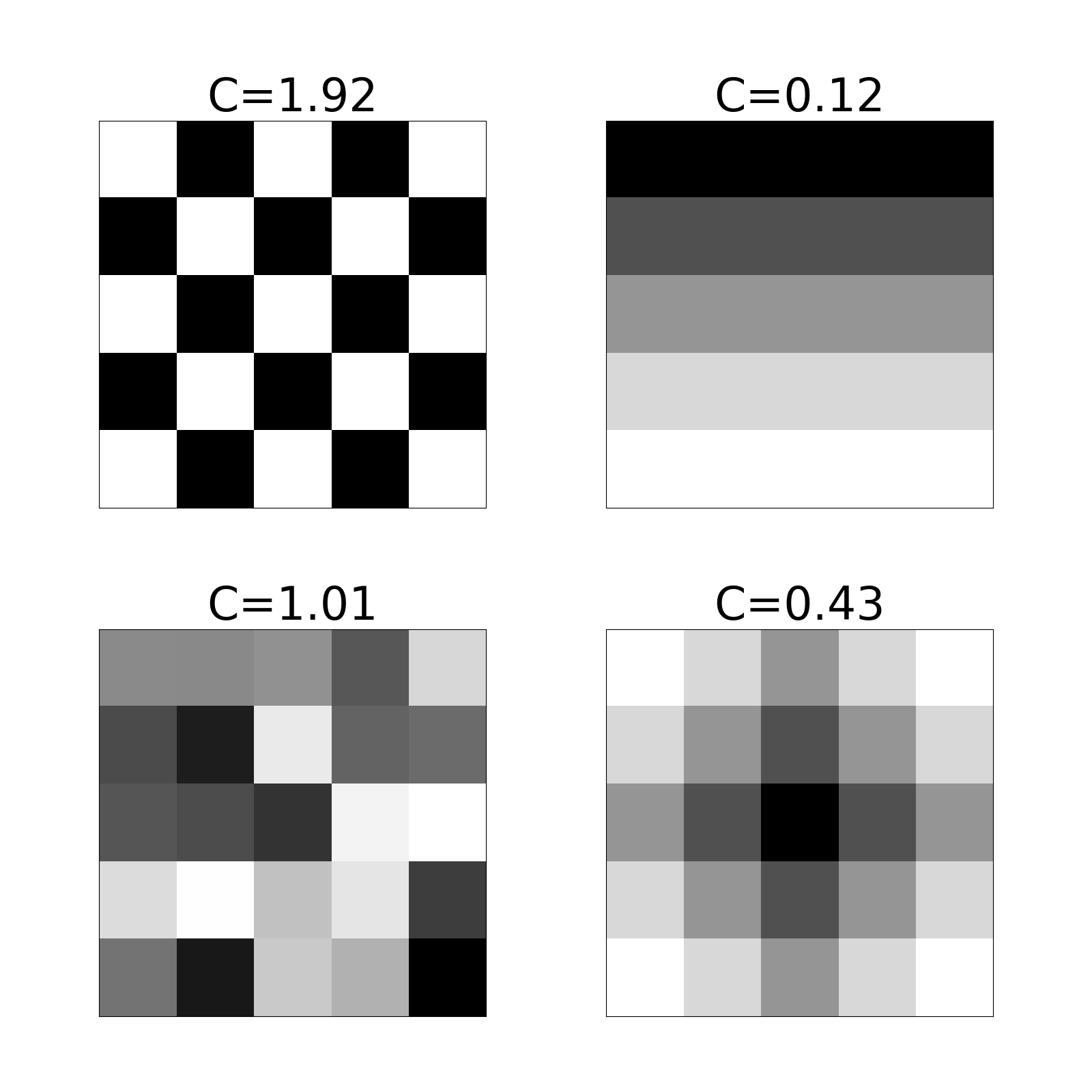Geary's C on:
[Wikipedia]
[Google]
[Amazon]
Geary's ''C'' is a measure of spatial
 The value of Geary's ''C'' lies between 0 and some unspecified value greater than 1. Values significantly lower than 1 demonstrate increasing positive spatial autocorrelation, whilst values significantly higher than 1 illustrate increasing negative spatial autocorrelation.
Geary's ''C'' is inversely related to Moran's ''I'', but it is not identical. While Moran's ''I'' and Geary's ''C'' are both measures of global spatial autocorrelation, they are slightly different. Geary's ''C'' uses the sum of squared distances whereas Moran's ''I'' uses standardized spatial covariance. By using squared distances Geary's ''C'' is less sensitive to linear associations and may pickup autocorrelation where Moran's ''I'' may not.
Geary's ''C'' is also known as Geary's contiguity ratio or simply Geary's ratio.
This statistic was developed by Roy C. Geary.
The value of Geary's ''C'' lies between 0 and some unspecified value greater than 1. Values significantly lower than 1 demonstrate increasing positive spatial autocorrelation, whilst values significantly higher than 1 illustrate increasing negative spatial autocorrelation.
Geary's ''C'' is inversely related to Moran's ''I'', but it is not identical. While Moran's ''I'' and Geary's ''C'' are both measures of global spatial autocorrelation, they are slightly different. Geary's ''C'' uses the sum of squared distances whereas Moran's ''I'' uses standardized spatial covariance. By using squared distances Geary's ''C'' is less sensitive to linear associations and may pickup autocorrelation where Moran's ''I'' may not.
Geary's ''C'' is also known as Geary's contiguity ratio or simply Geary's ratio.
This statistic was developed by Roy C. Geary.
autocorrelation
Autocorrelation, sometimes known as serial correlation in the discrete time case, measures the correlation of a signal with a delayed copy of itself. Essentially, it quantifies the similarity between observations of a random variable at differe ...
that attempts to determine if observations of the same variable are spatially autocorrelated globally (rather than at the neighborhood level). Spatial autocorrelation
Spatial analysis is any of the formal techniques which study entities using their topological, geometric, or geographic properties, primarily used in Urban Design. Spatial analysis includes a variety of techniques using different analytic appro ...
is more complex than autocorrelation
Autocorrelation, sometimes known as serial correlation in the discrete time case, measures the correlation of a signal with a delayed copy of itself. Essentially, it quantifies the similarity between observations of a random variable at differe ...
because the correlation is multi-dimensional and bi-directional.
Global Geary's C
Geary's ''C'' is defined as : where is the number of spatial units indexed by and ; is the variable of interest; is the mean of ; is the row of the spatial weights matrix with zeroes on the diagonal (i.e., ); and is the sum of all weights in . The value of Geary's ''C'' lies between 0 and some unspecified value greater than 1. Values significantly lower than 1 demonstrate increasing positive spatial autocorrelation, whilst values significantly higher than 1 illustrate increasing negative spatial autocorrelation.
Geary's ''C'' is inversely related to Moran's ''I'', but it is not identical. While Moran's ''I'' and Geary's ''C'' are both measures of global spatial autocorrelation, they are slightly different. Geary's ''C'' uses the sum of squared distances whereas Moran's ''I'' uses standardized spatial covariance. By using squared distances Geary's ''C'' is less sensitive to linear associations and may pickup autocorrelation where Moran's ''I'' may not.
Geary's ''C'' is also known as Geary's contiguity ratio or simply Geary's ratio.
This statistic was developed by Roy C. Geary.
The value of Geary's ''C'' lies between 0 and some unspecified value greater than 1. Values significantly lower than 1 demonstrate increasing positive spatial autocorrelation, whilst values significantly higher than 1 illustrate increasing negative spatial autocorrelation.
Geary's ''C'' is inversely related to Moran's ''I'', but it is not identical. While Moran's ''I'' and Geary's ''C'' are both measures of global spatial autocorrelation, they are slightly different. Geary's ''C'' uses the sum of squared distances whereas Moran's ''I'' uses standardized spatial covariance. By using squared distances Geary's ''C'' is less sensitive to linear associations and may pickup autocorrelation where Moran's ''I'' may not.
Geary's ''C'' is also known as Geary's contiguity ratio or simply Geary's ratio.
This statistic was developed by Roy C. Geary.
Local Geary's C
LikeMoran's I
In statistics, Moran's ''I'' is a measure of spatial autocorrelation developed by Patrick Alfred Pierce Moran. Spatial autocorrelation is characterized by a correlation in a signal among nearby locations in space. Spatial autocorrelation is more ...
, Geary's C can be decomposed into a sum of Local Indicators of Spatial Association (LISA) statistics. LISA statistics can be used to find local clusters through significance testing, though because a large number of tests must be performed (one per sampling area) this approach suffers from the multiple comparisons problem
Multiple comparisons, multiplicity or multiple testing problem occurs in statistics when one considers a set of statistical inferences simultaneously or estimates a subset of parameters selected based on the observed values.
The larger the numbe ...
. As noted by Anselin, this means the analysis of the local Geary statistic is aimed at identifying ''interesting'' points which should then be subject to further investigation. This is therefore a type of exploratory data analysis
In statistics, exploratory data analysis (EDA) is an approach of data analysis, analyzing data sets to summarize their main characteristics, often using statistical graphics and other data visualization methods. A statistical model can be used or ...
.
A local version of is given by
:
where
:
then,
:
Local Geary's C can be calculated in GeoDa and PySAL.
Sources
Spatial analysis Covariance and correlation {{stats-stub